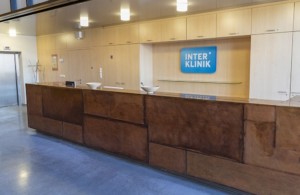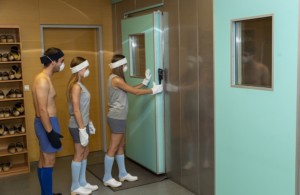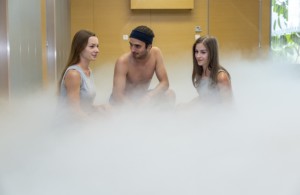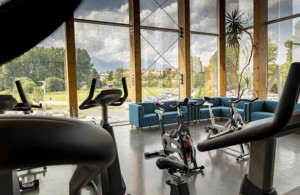CRYOCENTER
A therapeutic and rehabilitative method whose origins date back to the 1970s and 1980s.
The procedure involves a maximum three-minute stay in a chamber with an average temperature of –120 °C, followed by intensive exercise – kinesitherapy. A stay in this chamber under medical supervision stimulates the natural production of enzymes and hormones that support healing and can effectively “kick-start” the body’s self-healing and regeneration processes.
CRYOTHERAPY PROCESS
It stimulates receptors that respond only to cold. During the procedure, body temperature drops by only about 0.5 °C and skin temperature by a maximum of 3 °C. The effect of extreme cold on these receptors triggers a process that positively affects nerve endings and activates a response in the body – hormone production, increased metabolism, and reduced pain sensation. Exposure to extreme cold activates hormones and releases natural corticoids in amounts necessary to reduce inflammation, pain inhibitors, “endorphins – happiness hormones,” adrenaline, testosterone, and many other substances beneficial to the body.
CRYOTHERAPY PROCEDURE
Upon arrival at the cryocenter, clients receive a dry cotton T-shirt, shorts, headband, gloves, socks, wooden clogs, and a mask for the nose and mouth. Parts of the skin must remain uncovered to allow for stimulation of receptors. Before the main session, clients first enter an adaptation chamber at –60 °C for approximately 30 seconds. Then, they pass through inner doors into the main cryochamber, where the temperature reaches –120 °C. During the entire time inside, clients remain in motion, with no direct skin contact with the cold environment. After two to a maximum of three minutes, clients exit through the adaptation chamber, allowing the body to gradually adjust to the temperature change. After leaving the cryochamber, they engage in about 20 minutes of intensive physical exercise.
Read more about cryotherapy
- Local cryotherapy is successfully used in sports medicine and in the treatment of various conditions and injuries by applying cold directly to the affected area.
- The local application of cooled air is successfully used in sports medicine. It helps treat and reduce the effects of injuries, sprains, bruises, overtraining, hematomas, muscle spasms, and scars.
- It stimulates blood vessels, relieves pain, and supports the treatment of long-term illnesses.
- It helps in the treatment of musculoskeletal injuries – fractures, sprains, dislocations, and tendon or muscle tears, rheumatism, burns, various degenerative and inflammatory conditions, multiple sclerosis, and joint inflammations.
- Regular local cryotherapy treatment leads to faster healing of injuries, reduction of inflammation effects, and decreased swelling. Local cryotherapy can be combined with whole-body cryotherapy.
Whole-body cold regeneration can be undergone freely throughout life, continuously supporting health and improving quality of life without limitations.
- Cryotherapy is a therapeutic and rehabilitative method whose origins date back to the 1970s–1980s.
The procedure includes a maximum three-minute stay in a chamber with an average temperature of –120 °C, followed by intensive exercise – kinesitherapy. A stay in this chamber under medical supervision stimulates the natural production of enzymes and hormones that support healing and can “kick-start” self-healing and regeneration processes in your body.
By stimulating the body’s self-healing mechanisms, cryotherapy has a wide range of effects.
It is used in the treatment of conditions in rheumatology, pediatrics, orthopedics, surgery, neurosurgery, and physiotherapy. Scientific research, along with practical experience, has shown excellent results in the following diagnoses:
- Rheumatic diseases, gout, multiple sclerosis, changes in muscles, joints, and tendons after injuries (contusions, hematomas, and the like)
- Rheumatic diseases, gout, multiple sclerosis, changes in muscles, joints, and tendons after injuries (contusions, hematomas, and the like)
- paresis, spastic contractures of the limbs, primary and secondary osteoporosis, arthritis and arthrosis, fibromyalgia (pain in soft tissues around joints)
- Primary and secondary inflammatory changes, Alzheimer’s and Parkinson’s disease, post-stroke conditions, degenerative changes due to impaired motor nerve function.
- Psoriasis, dermatitis, eczema, plaque psoriasis, symptoms of migraines and depression
- Erectile dysfunction, insomnia and chronic fatigue, cellulite, menopause-related difficulties
The method is highly suitable for bacterial and non-bacterial joint inflammations, back and joint pain, and improving mobility in children with spinal bifida,
Cryotherapy significantly stimulates the human immune system, addresses skin diseases and eczema, psoriasis, cellulite, and is even used in invasive surgery – during operations. It has a beneficial effect on patients with malignant tumors in the incurable stage – primarily due to its analgesic effect and pain relief. It is also suitable for cardiovascular diseases, and for metabolic syndrome (diabetes, obesity, high blood pressure – depending on its origin), following a complete medical examination.
Cryotherapy treatment has shown a significant reduction in waist circumference, normalization of systolic blood pressure, an increase in so-called “good” cholesterol – HDL, and a positive impact on patients diagnosed with multiple sclerosis – specifically improved limb mobility.
It affects patients suffering from depression and stress – inducing feelings of joy, euphoria, warmth, and reducing anxiety (confirmed by 4 out of 5 visitors). Reported effects also include the disappearance of headaches, increased sexual activity, treatment of cold allergies, and relief from ringing in the ears.
Cryotherapy is intended for a wide range of people who suffer from health issues or are simply interested in improving their well-being.
Despite its wide range of positive effects, cryotherapy is not suitable for individuals with a cold allergy, pregnant women, or patients with untreated high blood pressure. Additional contraindications will be determined by a physician during a personal consultation and examination prior to the first cryochamber session.
Laboratory tests and practical experience have clearly demonstrated the cosmetic benefits of cold exposure, which are particularly sought after by women. Staying in the cryochamber visibly tightens the skin, rejuvenates and refreshes it, and thanks to the release of endorphins during therapy, also improves mood. Cryotherapy, through the effect of cold on skin layers and the resulting improved blood flow (which helps expel fat from cells), contributes to the reduction of cellulite and strengthens the resilience and quality of skin across the body. It actively supports weight loss and fat reduction, as well as easing symptoms related to menopause. Increased blood circulation in the kidneys leads to more efficient filtration, which supports the elimination of metabolic waste and contributes to overall detoxification of the body.
- It helps overcome chronic and “springtime” fatigue, significantly improves mood, relieves stress, and supports relief from depression and mood swings caused by changes in weather.
- Relieves tension and tight muscles, detoxifies the body, combats insomnia, promotes overall regeneration, and strengthens the immune system.
- It tightens and improves the condition of the skin, rejuvenates and refreshes, helps reduce cellulite, and in combination with follow-up exercise, supports weight loss and the reduction of excess body fat.
- Helps with menopause and migraines.
It helps athletes improve muscle performance, physical fitness, recovery before and after sports activities, and rehabilitation after injuries.
The release of hormones, especially testosterone, during cryotherapy is particularly beneficial for athletes. This phenomenon has a direct impact on muscle growth and increased performance during both strength and endurance training. It supports muscle relaxation, overall biological recovery, and—thanks to enhanced oxygenation—prevents the buildup of lactic acid.
Cryotherapy is widely used by top professional athletes as one of the most modern and effective forms of regeneration and performance enhancement through so-called “clean methods,” both before and after sports performance.
Slovak doctors who use the therapy in sports tested swimmers using blood tests and were able to demonstrate a twofold acceleration in biochemical regeneration after undergoing the therapy.
Several years of experience have led to the identification of conditions that make cryotherapy treatment unsuitable:
- Cold intolerance and allergy
- Fear of enclosed spaces – claustrophobia
- Hypothermia, Raynaud’s disease, Local circulation disorders
- Anemia, Use of certain medications – neuroleptics and alcohol
- Reduced thyroid function, Oncological diseases, Mental disorders associated with abnormal sweating
- Pregnancy, Infectious diseases
From the perspective of the circulatory system, whole-body cryotherapy is not recommended in the following cases:
- such as heart valve defects (valve stenosis), ischemic heart disease with circulatory insufficiency, and severe forms of asthma.
- severe diabetes, cardiac arrhythmias and resting heart rate above 100 beats per minute, pulmonary edema, and serious lung diseases.






